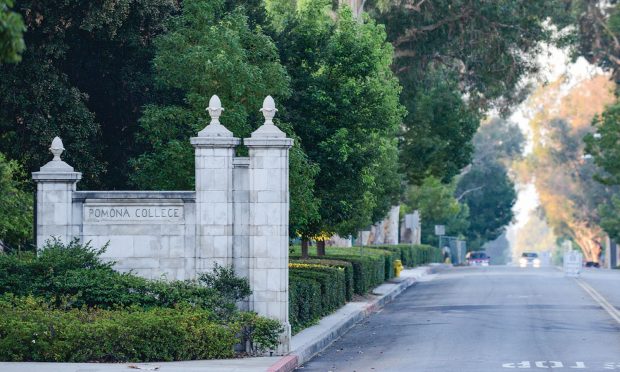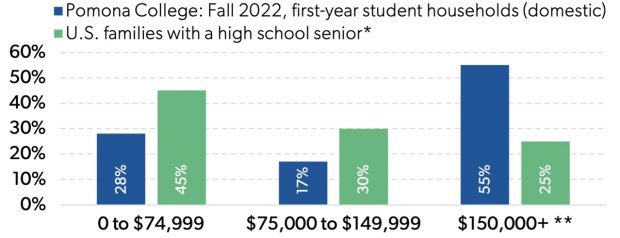
Over the course of the 20th century, American higher education became in many ways the repository of not just America’s dreams, but of much of the world’s. Young people and families from every corner of the globe have come to believe that one of the best paths to a future of prosperity and peace runs through colleges like Pomona: a liberal arts education can fulfill dreams that haven’t even yet been dreamt. I believe that to be true.
Indeed, in a model invented in the U.S., an education like that Pomona offers gives access to the full richness of the human inheritance—the accumulated knowledge of centuries—and also nurtures the yet-to-be-born discoveries that will shape our future. Liberal arts education carries this standard proudly, and does so by centering individual students in an intimate, nurturing and challenging environment where both our breadth and depth provide a foundation that helps students reach for the stars.
It’s now our moment to help show that the path of opportunity is wide open, and I ask you to join with me on this quest.”
I believe in this claim deeply. But I also know that the institutions that make this kind of education possible—and the dreams that we inspire—are fragile. Trust in higher education is at a low ebb, with a national survey conducted by Pew Research Center in early 2024 suggesting that 45% of Americans believe colleges and universities have a negative impact on the country today, while 53% cite a positive impact.
Political turmoil is part of it. But it is more than that: The cost of college education has become prohibitive for many students and families, particularly those who are neither eligible for large amounts of financial aid nor wealthy enough to pay a sum for four years at a private college that in some parts of the country is enough to buy a house.
Pomona has done good work as an engine of opportunity. We are what The New York Times has called one of the top colleges doing the most for the American Dream because of our need-blind admission, our no-loan aid and our exceptional graduation rates. Due to improvements in financial aid, we are one of a handful of colleges nationwide where the net cost of attendance for families receiving aid has stayed near constant over the last 15 years. All kinds of dreamers who come to Pomona have the chance to flourish, and to bear their added gifts in trust for all.
But for some, their dream still seems out of reach. In our strategic planning process, we came to realize exactly that. For example, in 2022, while about 28% of Pomona’s first-year students from the U.S. came from households with incomes of less than $75,000 a year, the majority—55%—came from households with incomes of $150,000 or more. That means that 83% of our first-year students represented opposite ends of the income spectrum. Only 17% were from families with incomes in the $75,000 to $150,000 range—what many call “middle class,” though we prefer to dispense with the idea of class and address levels of income.

Income distribution for first-year students at Pomona College (Fall 2022) compared to national data for families with a high school senior*. Nationally, 45% fall under $75,000, 30% between $75,000 and $149,999, and 25% at $150,000 or more**. For Pomona College students: 28% fall under $75,000, 17% between $75,000 and $149,999, and 55% in the $150,000+ bracket.
* Source (U.S. Family Income): U.S. Census Bureau, American Community Survey 2021.
** Includes families with unknown incomes who did not apply for financial aid.
While we proudly reflect the racial and ethnic diversity of this country, we do not fully reflect the economic spectrum. Thus, our Middle Income Initiative was born.
This is an urgent call, because we are not alone in having something of a ‘barbell’ distribution of our students.”
We seek in the coming years to increase the number of students from middle-income families who attend Pomona. This starts with who applies. In recent years the portion of applicants from middle-income households has been nowhere near representative, partly because the cost can seem out of reach and also because few outside programs and scholarships focus on middle-income students. Our admissions staff will be working to expand our reach, helping students know more about Pomona.
The financial considerations are significant. Even with the generous financial aid that Pomona offers—among the best in the country—many middle-income families still believe they cannot afford to come and students don’t even apply. We aim to change that, by raising enough funds to increase what we can offer to middle-income families upfront and by providing a price guarantee that simplifies the college search process and helps students see that Pomona can work for them.
The fundraising for this has begun and will require a significant philanthropic investment from Sagehens to realize. The recruitment for this also has begun, as we have opened our doors to more transfers from community colleges, to maximize our reach and offer a Pomona education to as many brilliant students as we can.
This is an urgent call, because we are not alone in having something of a “barbell” distribution of our students. In 2017, the research and policy group now known as Opportunity Insights found that at 38 U.S. colleges and universities the number of students from households with incomes in the top 1% exceeded the number from the bottom 60%. That group did not include Pomona, but it did include five Ivy League universities and numerous liberal arts colleges. Flagship public institutions have become more expensive too, as a proportion of family income, for lower-income and middle-income students than for students from the richest families.
Collectively, it looks as if we all represent a dream deferred. But Pomona will continue to show the way forward. We have proven that diversity and excellence go hand in hand. It’s now our moment to help show that the path of opportunity is wide open, and I ask you to join with me on this quest. For Pomona to be great, we must, truly, bear our riches in trust for all.
G. Gabrielle Starr took office as president of Pomona College in 2017. A national voice on access to college for students of all backgrounds and on the future of higher education, she is working to ensure students from the full range of family incomes enroll in college and thrive.
